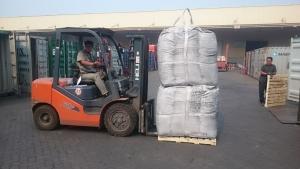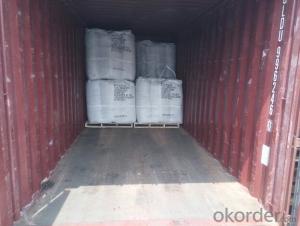Graphite Petroleum Coke with lower Sulphur0.03% max in Low VM
- Loading Port:
- Tianjin
- Payment Terms:
- TT OR LC
- Min Order Qty:
- 21 m.t.
- Supply Capability:
- 5000 m.t./month
OKorder Service Pledge
OKorder Financial Service
You Might Also Like
Introduction:
GPC has good characteristics with low ash, low resistivity, low sulphur, high carbon and high density. It is the best material for high quality carbon products. It is used as carbon additive in steel industry or fuel.
Features:
1.Our strong team provide you reliable service that make you feel purchasing is more easier
2. We ensure that we can supply capability with competitive price.
3. Work strictly to guarantee product quality,
4. Highest standard of integrity. Guarantee customer's benefit.
5. Supplying Pet Coke, Met coke, Foundry Coke, Carbon Raiser etc.
Specifications:
F.C.% | 95MIN | 94MIN | 93MIN | 92MIN | 90MIN | 85MIN | 84MIN |
ASH % | 4MAX | 5MAX | 6 MAX | 6.5MAX | 8.5MAX | 12MAX | 13MAX |
V.M.% | 1 MAX | 1MAX | 1.0MAX | 1.5MAX | 1.5MAX | 3 MAX | 3 MAX |
SULFUR % | 0.3MAX | 0.3MAX | 0.3MAX | 0.35MAX | 0.35MAX | 0.5MAX | 0.5MAX |
MOISTURE % | 0.5MAX | 0.5MAX | 0.5MAX | 0.5MAX | 0.5MAX | 1MAX | 1MAX |
Pictures



FAQ:
1. Your specification is not very suitable for us.
Please offer us specific indicators by TM or email. We will give you feedback as soon as possible.
2. When can I get the price?
We usually quote within 24 hours after getting your detailed requirements, like size, quantity etc. .
If it is an urgent order, you can call us directly.
3. Do you provide samples?
Yes, samples are available for you to check our quality.
Samples delivery time will be about 3-10 days.
4. What about the lead time for mass product?
The lead time is based on the quantity, about 7-15 days. For graphite product, apply Dual-use items license need about 15-20 working days.
5. What is your terms of delivery?
We accept FOB, CFR, CIF, EXW, etc. You can choose the most convenient way for you. Besides that,
we can also shipping by Air and Express.
6. Product packaging?
We are packed in bulk ship or in ton bag or placing in container or according to your requirements.
7. Notice
please note that the price on Alibaba is a rough price. The actual price will depends on raw materials, exchange rate wage and your order quantity .Hope to cooperation with you, thanks !
- Q: What is the role of carbon in the formation of diamonds?
- The role of carbon in the formation of diamonds is crucial as it is the sole element responsible for the creation of these precious gemstones. Diamonds are formed deep within the Earth's mantle, under extreme pressure and temperature conditions. Carbon atoms, when subjected to immense pressure and heat, undergo a process called graphitization, where they rearrange their atomic structure and transform into a crystal lattice arrangement, giving rise to the formation of diamonds. The process starts with carbon-rich materials, such as organic matter or carbon-bearing minerals, being exposed to the intense heat and pressure found deep within the Earth's mantle, typically at depths of around 150 to 200 kilometers. Under these conditions, the carbon atoms within these materials are forced to bond together in a unique way, forming the rigid, three-dimensional lattice structure characteristic of diamonds. The formation of diamonds requires specific geological conditions, including temperatures above 900 degrees Celsius and pressures exceeding 725,000 pounds per square inch (50,000 atmospheres). These extreme conditions are typically found in areas where ancient tectonic plates collide or in volcanic eruptions that bring diamonds to the Earth's surface. Carbon's ability to form strong covalent bonds with other carbon atoms is what allows the transformation into diamonds. Each carbon atom forms four strong covalent bonds, creating a tetrahedral structure. This strong bonding allows diamonds to possess exceptional hardness, making them one of the hardest substances known to man. In summary, carbon plays an essential role in the formation of diamonds, undergoing graphitization under immense pressure and temperature conditions to create the unique crystal lattice structure that gives diamonds their extraordinary properties. Without carbon, the formation of diamonds as we know them would not be possible.
- Q: How can I see if a battery can be used to recharge it?Can not all carbon batteries charge?
- Can not but about 4 times more than that of carbon battery alkaline batteries we usually use 5 batteries and 7 batteries into several carbon batteries alkaline batteries, carbon battery prices cheaper than half cheaper but durable alkaline battery alkaline batteries and strong power in general can reach carbon batteries are not can charge are one-time non rechargeable battery voltage both 1.5V are generally belongs to the zinc manganese batteryNo. 5 and No. 7 rechargeable battery is generally divided into two kinds of nickel cadmium battery NiMH battery is the two voltage of Ni MH battery capacity rechargeable nickel cadmium batteries so the current market is generally greater than the mountain NiCd battery has been relatively rare these two batteries each day is 1.2V can be chargedNote that our commonly used mobile phone lithium battery voltage is generally about 3.6 to 3.7V, or 3.6 multiples, so do not make the No. 5 or 7 batteries
- Q: How does carbon affect the pH of rainwater?
- The pH of rainwater can be influenced by carbon, which occurs when carbon dioxide (CO2) in the atmosphere dissolves in rainwater. This process is known as the formation of carbonic acid (H2CO3). As a result of this reaction, the pH of rainwater decreases, making it more acidic. The carbonic acid breaks down into hydrogen ions (H+) and bicarbonate ions (HCO3-), which further contribute to the acidity of rainwater. Consequently, higher levels of carbon dioxide in the atmosphere, such as those caused by human activities like the combustion of fossil fuels, can result in an increase in the formation of carbonic acid and subsequently lower the pH of rainwater, leading to the occurrence of acid rain.
- Q: How does carbon impact the prevalence of avalanches?
- The prevalence of avalanches is greatly influenced by carbon. The rise in carbon emissions and subsequent global warming results in alterations to the stability of snowpack, ultimately impacting the frequency and severity of avalanches. As temperatures increase, snowfall patterns become more uncertain, characterized by more frequent freeze-thaw cycles. This causes the snowpack to weaken, as the snow loses its cohesion and becomes more prone to sliding. Moreover, higher temperatures lead to a greater amount of rainfall instead of snow, further destabilizing the snowpack by adding weight and reducing its strength. These changes in snowpack stability heighten the probability of avalanches occurring. Additionally, climate change also modifies the timing and duration of snow accumulation. Warmer temperatures result in earlier snow melt, which can result in a diminished snowpack during the peak avalanche season. This, in turn, increases the likelihood of triggering avalanches as there is a smaller amount of stable snow to support the added weight and stress from additional snowfall or human activity. Furthermore, carbon-induced climate change has the ability to affect the frequency and intensity of extreme weather events, such as heavy snowfalls or rainstorms. These events can cause rapid and significant alterations to snowpack conditions, ultimately leading to an elevated risk of avalanches. In conclusion, the impact of carbon on the prevalence of avalanches is substantial. The warming climate affects snowpack stability, the timing and duration of snow accumulation, and the frequency of extreme weather events, all of which contribute to an increased risk and prevalence of avalanches.
- Q: What is carbon footprint labeling?
- Carbon footprint labeling is a system that provides information about the carbon emissions associated with a product or service. It aims to educate consumers about the environmental impact of their purchases and enable them to make more sustainable choices. The labeling typically includes a measure of the greenhouse gas emissions produced during the entire life cycle of a product, including its production, transportation, and disposal. This allows consumers to compare the carbon footprints of different products and make informed decisions based on their environmental values. Carbon footprint labeling is an important tool in promoting sustainability and encouraging businesses to reduce their emissions. It also raises awareness about the impact of individual consumption choices on climate change and encourages a shift towards more environmentally friendly alternatives.
- Q: Wrought iron, steel, cast iron, cast iron, according to the content of the carbon? How many?
- That is not all according to the carbon content is divided. Because the carbon content of iron and iron.
- Q: What is sintered carbon?
- Sintered carbon is generally used as a filter element, and also of good quality, but very few, most of which are of poor quality.Sintering is the process in which powder or powder compacts are heated to a temperature below the melting point of the basic component and then cooled to room temperature at a certain rate and speed. The result of sintering is bonding between the powder particles, increasing the strength of the sintered body, and changing the aggregate of the powder particles into agglomerates of grain to obtain the desired physical or mechanical properties of the product or material.The sintering process refers to the processing program and the sintering process system selected according to the characteristics of the feedstock. It has a direct and important influence on the production and quality of sinter production.
- Q: What are the main sources of carbon on Earth?
- The main sources of carbon on Earth are the atmosphere, oceans, geological processes, and living organisms.
- Q: How are carbon nanotubes produced?
- Carbon nanotubes are typically produced through a process called chemical vapor deposition (CVD), where a carbon-containing gas is introduced into a high-temperature reactor. Under controlled conditions, the carbon atoms assemble and form nanotubes on a catalyst surface, such as iron or nickel. Other methods, including arc discharge and laser ablation, can also be used to produce carbon nanotubes.
Send your message to us
Graphite Petroleum Coke with lower Sulphur0.03% max in Low VM
- Loading Port:
- Tianjin
- Payment Terms:
- TT OR LC
- Min Order Qty:
- 21 m.t.
- Supply Capability:
- 5000 m.t./month
OKorder Service Pledge
OKorder Financial Service
Similar products
Hot products
Hot Searches


























